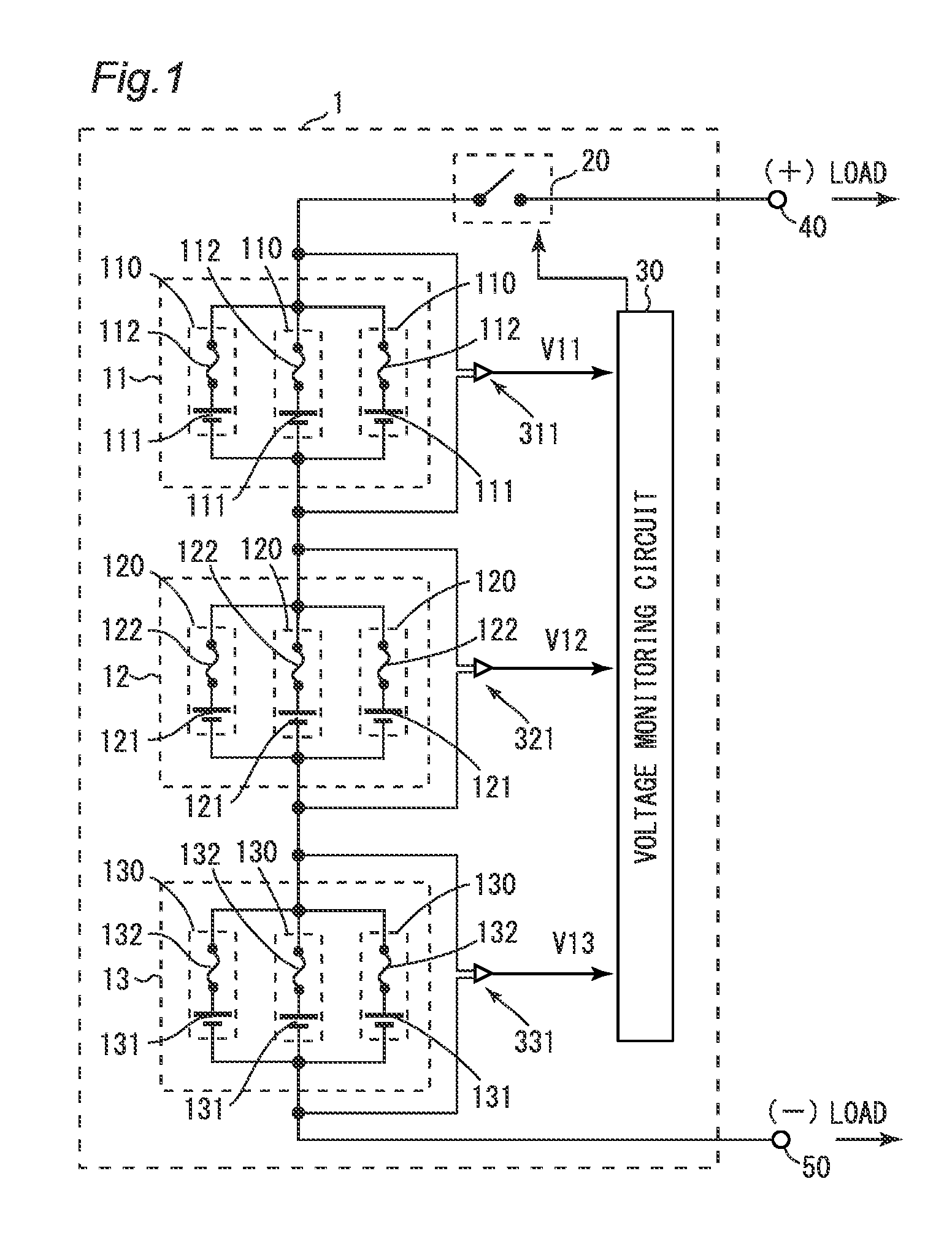Battery unit
a battery unit and battery technology, applied in the field of batteries, can solve the problems of complex circuitry of conventional battery units and complex circuitry of 3 batteries, and achieve the effect of simple circuitry
- Summary
- Abstract
- Description
- Claims
- Application Information
AI Technical Summary
Benefits of technology
Problems solved by technology
Method used
Image
Examples
first embodiment
[0029]Referring to FIGS. 1 to 5, a battery unit 1 according to a first embodiment will be described. FIG. 1 is a circuit diagram showing the circuit structure of the battery unit 1 of the first embodiment.
[0030]The battery unit 1 includes battery subunits 11, 12 and 13, a switch 20, voltage detectors 311, 321 and 331, and a voltage monitoring circuit 30. Identification information ID11, ID12 and ID13 are associated with the battery subunits 11, 12 and 13, respectively. The identification information ID11, ID12 and ID13 are information used to identify the battery subunits 11, 12 and 13, respectively.
[0031]The battery subunits 11, 12 and 13 are connected in series between a plus terminal 40 and a minus terminal 50. The battery subunit 11 includes three battery modules 110. The three battery modules 110 are connected in parallel between the switch 20 and the battery subunit 12. Each battery module 110 includes a secondary battery cell 111 and a fuse 112. The secondary battery cell 111...
second embodiment
Variations of Second Embodiment
[0112]In the second embodiment, the battery module 110 includes one secondary battery cell 111, however, the embodiment is not limited to such a configuration. For example, the battery module 110 may include a plurality of secondary battery cells 111 connected in series.
[0113]In the above description, the switch 20 is connected between the positive electrode terminal of the battery subunit 11 and the load, however, the embodiment is not limited to such a configuration. The switch 20 may be connected between the negative electrode terminal of the battery subunit 11 and the load.
Third Embodiment
[0114]Next, referring to FIGS. 9 and 10, a battery unit 1Y of a third embodiment will be described. FIG. 9 is a circuit diagram showing the circuit structure of the battery unit 1Y of the third embodiment.
[0115]The battery unit 1Y of the third embodiment is similar to the battery unit 1 except for replacing the battery subunit 11 of the battery unit 1 shown in FIG...
third embodiment
Variations of Third Embodiment
[0127]In the third embodiment, the battery module 110 includes one secondary battery cell 111, however, the embodiment is not limited to such a configuration. For example, the battery module 110 may include a plurality of secondary battery cells 111 connected in series.
[0128]In the above description, the switch 20 is connected between the positive electrode terminal of the battery subunit 11Y and the load, however, the embodiment is not limited to such a configuration. The switch 20 may be connected between the negative electrode terminal of the battery subunit 11Y and the load.
[0129]In the above description, if the voltage V11Y received from the voltage detector 311Y is zero, the voltage monitoring circuit 30Y turns the switch 20 off (step S53), however, the embodiment is not limited to such a configuration. Step S53 of the third switch control process (FIG. 10) may be eliminated. This is because the battery unit 1Y is not able to supply power to the l...
PUM
| Property | Measurement | Unit |
|---|---|---|
| rated current | aaaaa | aaaaa |
| rated current | aaaaa | aaaaa |
| voltage | aaaaa | aaaaa |
Abstract
Description
Claims
Application Information
 Login to View More
Login to View More - R&D
- Intellectual Property
- Life Sciences
- Materials
- Tech Scout
- Unparalleled Data Quality
- Higher Quality Content
- 60% Fewer Hallucinations
Browse by: Latest US Patents, China's latest patents, Technical Efficacy Thesaurus, Application Domain, Technology Topic, Popular Technical Reports.
© 2025 PatSnap. All rights reserved.Legal|Privacy policy|Modern Slavery Act Transparency Statement|Sitemap|About US| Contact US: help@patsnap.com



